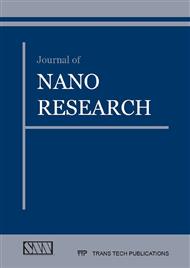[1]
M.C. Roco, Broader societal issues of nanotechnology, J Nano. Res. 5 (2003) 181–189.
Google Scholar
[2]
R.N. Parmar, J.H. Markna, P.S. Solanki, R.R. Doshi, P.S. Vachhani, D.G. Kuberkar, Grain Size Dependent Transport and Magnetoresistance Behavior of Chemical Solution Deposition Grown Nanostructured La0. 7Sr0. 3MnO3 Manganite Films, J Nanoscience and Nanotechnology. 8 (2008).
DOI: 10.1166/jnn.2008.an51
Google Scholar
[3]
J.H. Markna, P.S. Vachhani, R.N. Parmar, D.G. Kuberkar, P. Mishra, B.N. Singh, L.M. Kukreja, D.S. Rana, Enhancement of electronic transport and magnetoresistance of Al2O3-impregnated (La0. 5Pr0. 2)Sr0. 3MnO3 thin films, Euro. Phys. Lett. 79 (2007).
DOI: 10.1209/0295-5075/79/17005
Google Scholar
[4]
Ma. J. Guajardo-Pacheco, J.E. Morales-Sanchz, J. Gonzalez-Hernandez, F. Ruiz, Synthesis of copper nanoparticles using soybeans as a chelant agent, Mater. Lett. 64 (2010) 1361-1364.
DOI: 10.1016/j.matlet.2010.03.029
Google Scholar
[5]
Y. Xi, C. Hu, P. Gao, R. Yang, X. He, X. Wang, B. Wan, Morphology and phase selective synthesis of CuxO (x=1, 2) nanostructures and their catalytic degradation activity, Mat. Scie. and Eng. 166 (2010) 113-117.
DOI: 10.1016/j.mseb.2009.10.008
Google Scholar
[6]
Y. He, Novel solid stabilized Emulsion approach to CuO nanostructure microspheres, Mat. Res. Bull. 42 (2007) 190-195.
DOI: 10.1016/j.materresbull.2006.05.020
Google Scholar
[7]
X. Qijie, L. Xiaohong, Z. Zhijung, Preparation of Copper nanoparticles-improved polyamide 6 composites by an in situ solution rout with cupric oxide as the metallic copper source and investigation of their properties, New J. Chem. 39 (2015).
DOI: 10.1039/c4nj02302a
Google Scholar
[8]
K. Phiwdang, S. Suphankij, W. Mekprasart, W. Pecharapa, Synthsis of CuO Nanoparticles by precipitation method using different precursors, Energy Procedia. 34 92013) 240-245.
DOI: 10.1016/j.egypro.2013.06.808
Google Scholar
[9]
H. Kawasaki,Y. Kosaka, Y. Myoujin, T. Narushima, T. Yonezawa, R. Arakawa, Microwave assisted polyol of synthesis of copper nanocrystals without using additional protective agents, Chem. Commun. 47 (2011) 7740–7742.
DOI: 10.1039/c1cc12346g
Google Scholar
[10]
G. Socrates, Infrared and Raman Characteristic Group Frequencies, third ed., John Wiley & Sons Ltd, (2004).
DOI: 10.1002/jrs.1238
Google Scholar
[11]
C.A. Melendres, G.A. Bowmaker, J.M. Leger, B.J. Beden, In-situ synchrotron far infrared spectroscopy of surface lms on a copper electrode in aqueous solutions, J. Electroanal. Chem. 449 (1998) 215-218.
DOI: 10.1016/s0022-0728(97)00609-8
Google Scholar
[12]
M.P. Pileni, I. Lisiecki, Nanometer Metallic Copper Particle Synthesis in Reverse Micelles, Colloids and Surfaces A: Physicochemical and Engineering Aspects. 80. 1 (1993) 63-68.
DOI: 10.1016/0927-7757(93)80224-3
Google Scholar
[13]
Q. Xie, F. McCourt, Nanotechnology Engineering NE 320L Lab Manual, University of Waterloo. (2008) 23-30.
Google Scholar


